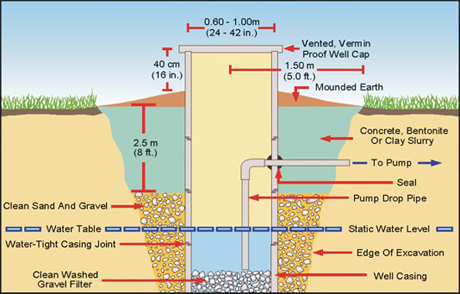Protecting Rural Wells
The Source
People living in areas without a piped-in municipal water supply must find their own source of pure water. While some people gather rain water into cisterns or draw water directly from a lake or stream, the most common method is to dig or drill a private well. Well water needs to be tested when the well is first dug or drilled, and then tested regularly afterwards, to make sure that the water is still uncontaminated. New housing, industrial, or agricultural developments in surrounding areas can contaminate well water that was formerly safe to drink, as can the runoff from unusually heavy rain or rapid snowmelt.

A properly constructed well
© Queen’s Printer for Ontario, 2003. Reproduced with permission.
Treatment
If disease-causing microorganisms are present, or if coliform bacteria (E. coli) are detected, the water needs to be disinfected. Most coliforms do not make people sick, but they are an indicator that faecal matter is entering the water supply, and therefore, that the water supply is at risk.
Owners can install a treatment system that uses chlorine, iodine, ozone, or ultraviolet light to kill pathogens. Or they may choose to boil their water before using it, especially if the contamination is thought to be a one-time, short-term event, caused by something like torrential rains and flooding.
Preventing Contamination After Treatment
When water is pumped on demand from a well directly into the water pipes of a dwelling, there is very little risk of contamination. If well water is pumped into a cistern and stored - a system that is used in areas where wells sometimes run dry - the cistern must be kept secure and free from contamination.
Municipal Water Supply
Wilderness Areas
Strategies for Less-Developed Areas


